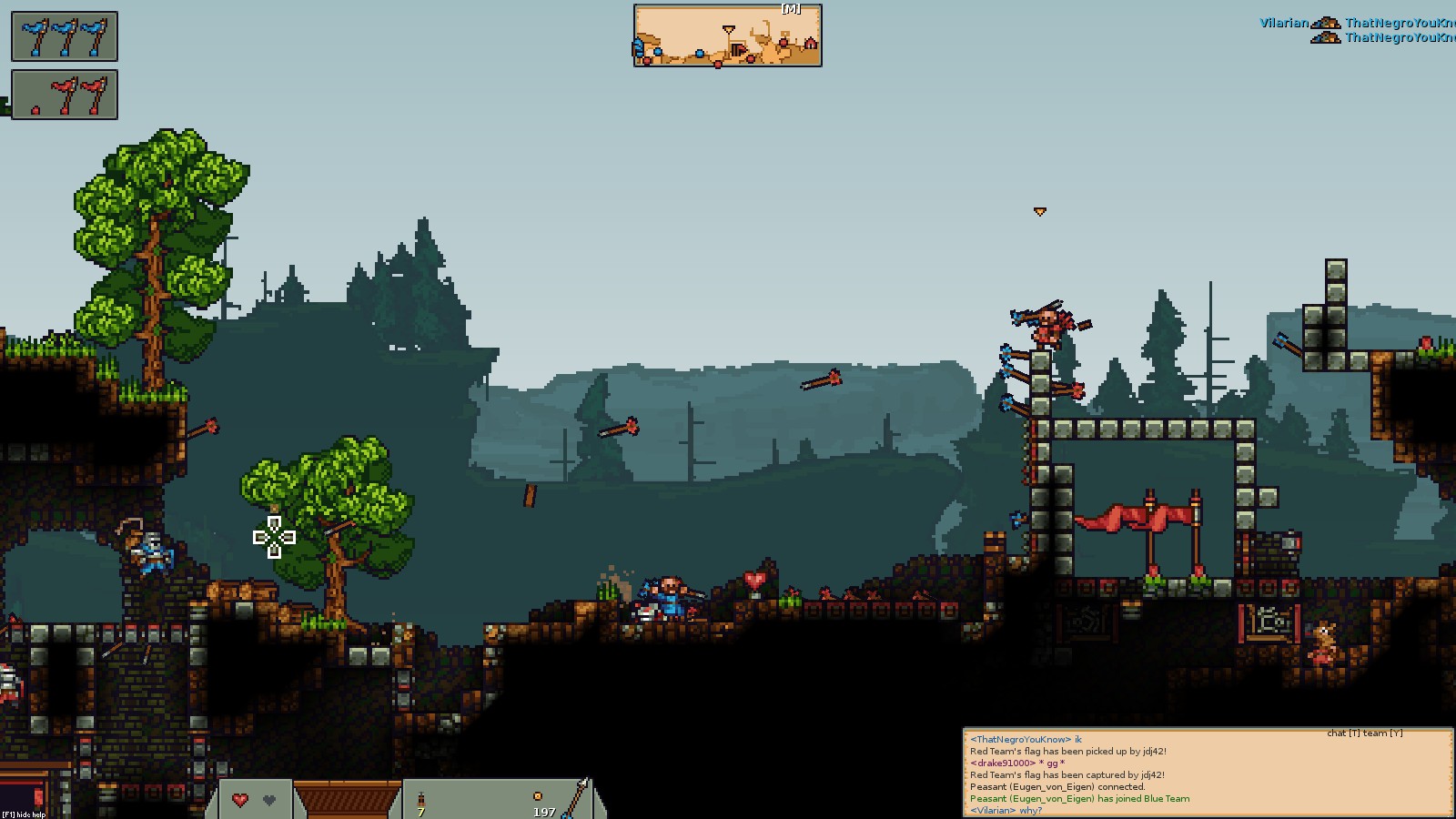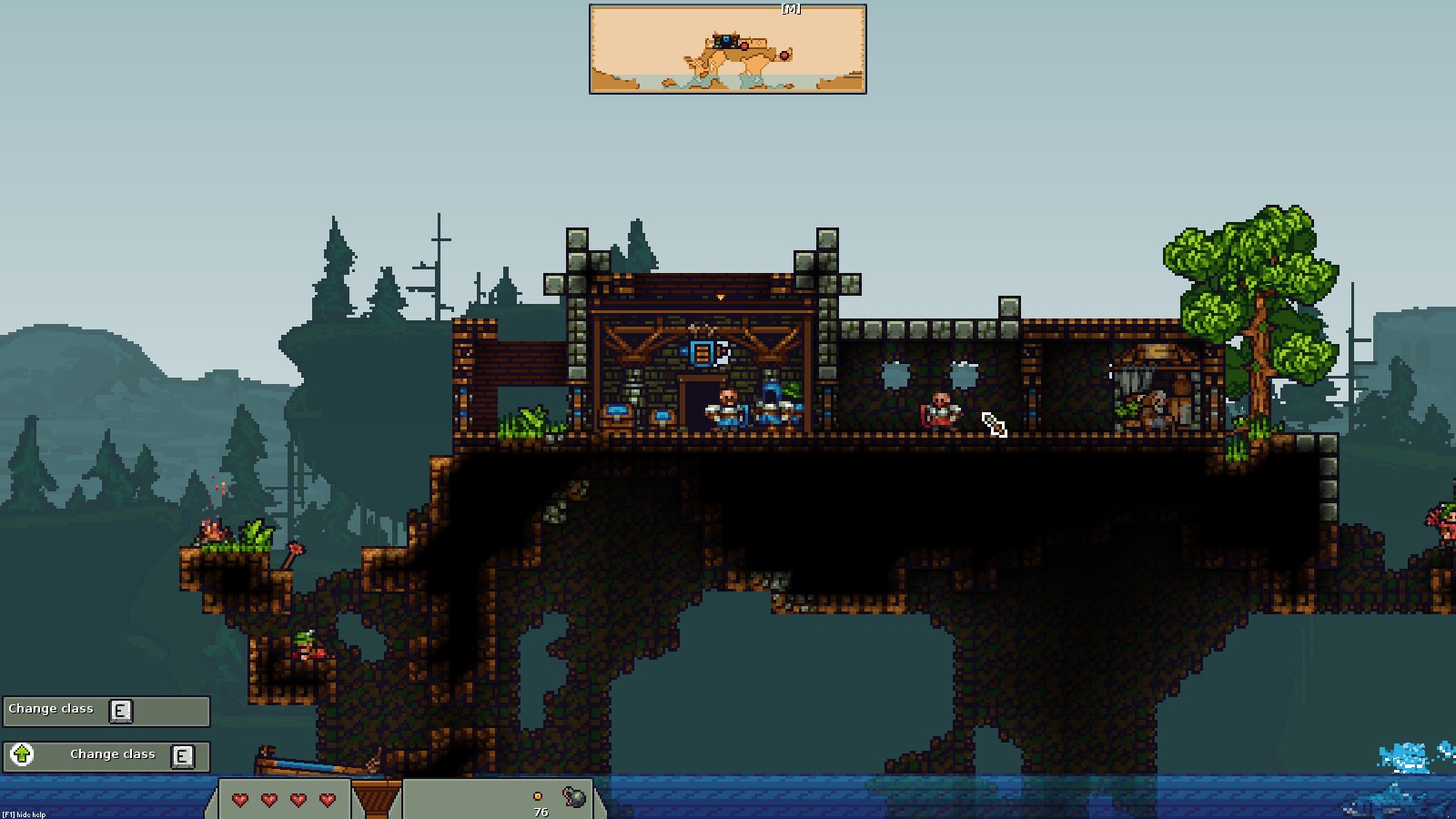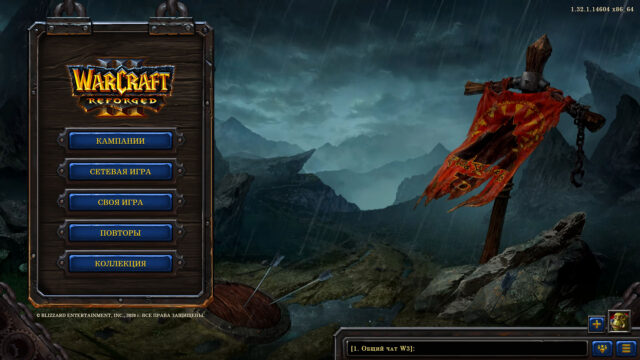King Arthur’s Gold Review

King Arthur’s Gold appeared a long time ago and remained unnoticed in the shadow of similar games like Terraria, Minecraft, and Ace of Spades for several years. At that time, its creators (the same people who gave us Soldat) methodically and patiently crafted a small but proud game about crazy sieges. Now it has acquired a more or less final form and has become good enough for Steam. It is time to give this medieval game the attention it deserves.
First of all, I consider it excellent. The concept is simple – two teams of 16 people build fortifications on their bases while attacking each other with ballistae, catapults, arrows, bombs, warships, and old good sharp swords. You have three types of battle-hardened heroes at your disposal – knights, archers, and builders. I mostly played as a builder, constructing tower fortifications and deadly spike traps and trapdoors. I love games where I can recreate my gloomy childhood doodles from art class (Mariivanna, look, I drew a crusher!). Later, when my teammates shared the intricacies of castle architecture, I could attach those same spikes to the walls, making them completely impregnable to everything except catapults and explosives.
This is one of those games that start quite reasonably and become more insane as you go along. Sometimes what happens is so amusing that you involuntarily get distracted from building, zoom out, and admire the bloody battles under the walls of your fortress. I am pleased to report that the chaos shown in the release trailer is not an exceptional case. It is a normal course of events in the unoccupied territory between the opposing sides. There are long battles when both teams build such reliable fortresses that a frantic arms race begins and increasingly desperate strategies for victory are devised, even to the point of kamikaze sacrificing their lives to break through the wall.

Here’s how a typical session in King Arthur’s Gold can go: Woke up. Chopped down a tree. Gathered stone. Built a tower. Switched class to archer. Crafted fire arrows. Shot a fire arrow. Set a drawbridge on fire. Smiled. Jumped off the tower. Released a rope with a hook! Shot multiple times in Legolas style while descending on the rope. Switched class to knight. Climbed into a catapult. Catapulted myself. Wheeeee! Flew to the lake in the center of the map, using a shield as a glider. Encountered a shark. Swam on the shark across the lake. Enemy fortifications! Sliced the archer. Sliced the knight. Planted a mine at the doors. Run! Didn’t escape. Killed by a boat falling on my head.
The pleasure is not only in building your fort or changing the terrain with deadly traps, but also in comparing yourself with the enemy’s progress, thinking about how to get rid of their weapons or overcome a minefield. You can team up with someone and build a bridge over the mines or hand a drill to an enterprising and brave builder to dig a tunnel from below. There will inevitably be those who think the best solution is to jump on the mines to make them disappear, but if the enemy is not foolish, they always keep an endless supply of explosives. And this is where King Arthur’s Gold becomes much more cunning.
In the Take the Halls mode, where I spend most of my time, you can explore new technologies. For example, you can vote to research drilling tools, boats, lanterns, or maybe arrows with bombs attached to them. All of this will have its use. However, to set up production, builders will have to build workshops for each specific industry. Moreover, you will need to hire a worker for the shop. And this requires money, and here the gold from the title reminds us of its important role. In the Capture the Flag mode, you can get by without worrying about a gold reserve. But in Take the Halls, a team that doesn’t focus on the precious metal will be defeated by the enemy with better equipment. So, when you see two workers fighting near a dirt mound or a knight chopping down a tree where an archer is hiding, you can be assured that behind all this madness, there is a method. Strategy and thoughtful management serve as a foundation for arcade brawls on the other side of the wall.

I must admit, my first impressions of the game were not so bright. When the game was released on Steam, there was a bug that hid the tutorial text. So, when I wanted to understand how to do something simple, like changing classes, I had to take the hard way. It took me a whole hour to figure out just the basics (and much more to understand the intricacies of resource distribution), which made me think that the interface was not very intuitive. But once I got the hang of the builder class, the game opened up to me and I forgot about the early problems. And I didn’t have time to think about them either. I flew across the map, landed in a secret tunnel, dug my way to enemy traps, and slowly disabled them. The tutorial bug was eventually fixed, but even without it, I would consider the non-obviousness of KAG quite forgivable.
If there’s one thing that annoys me in the game, it’s the matches that can end at any moment. Usually, this happens when someone suddenly ends up in the minority. It happened to me when I was building a beautiful castle with lots of workshops. I made it as fortified as possible, carefully reinforcing the walls with additional layers of stone. To support the structure, I used wooden braces, because here, unlike in Minecraft, individual elements don’t float in the air and walls can collapse. When your tower collapses right on top of you, it creates a wonderful loud crash.
I was eagerly waiting for the enemy to appear, but with the final touch I added to my spiked wall, my team crushed the remaining guerrillas on the eastern front. No one even had time to aim an arrow at me.

Although such cases are rather rare. And in general, if your main complaint is “oh, nobody even killed me”, then the problem is definitely not with the game itself. Not that there are no problems here at all. The game doesn’t bother explaining the details of different modes, and you’re left to either learn from others or accidentally discover some exotic techniques, like riding a shark. But the same can be said about Terraria and Minecraft – these games require taking a course of lectures on YouTube and obtaining a diploma in studying the corresponding wikis. However, don’t be deceived – King Arthur’s Gold is in no way comparable to these two in terms of depth. However, it looks in the same direction as the third one – Ace of Spades.
In the original version of that game (before Jagex took full control), I was tunneling to the other side of the map with all the caution provided by the sound of the pickaxe. This reminded me of Sebastian Faulks’ book “Birdsong”, where soldiers during World War II were digging tunnels towards the enemy, constantly listening for the rustling of the Germans doing the same thing in the opposite direction. It may seem silly that colorful reckless games evoke memories of such dark and serious literature, but that’s exactly what KAG is capable of in its best moments. And it’s also perceived as funny in it. At a price of $12, this game is impossible not to recommend.
And also, we have here…Sudden distribution of keysThe first two commenters on the reader’s review will receive a Steam copy of the game. Hurry up!
Share
Discuss
More Reviews





